“One daffodil is worth a thousand pleasures, then one is too few.” ~ William Wordsworth
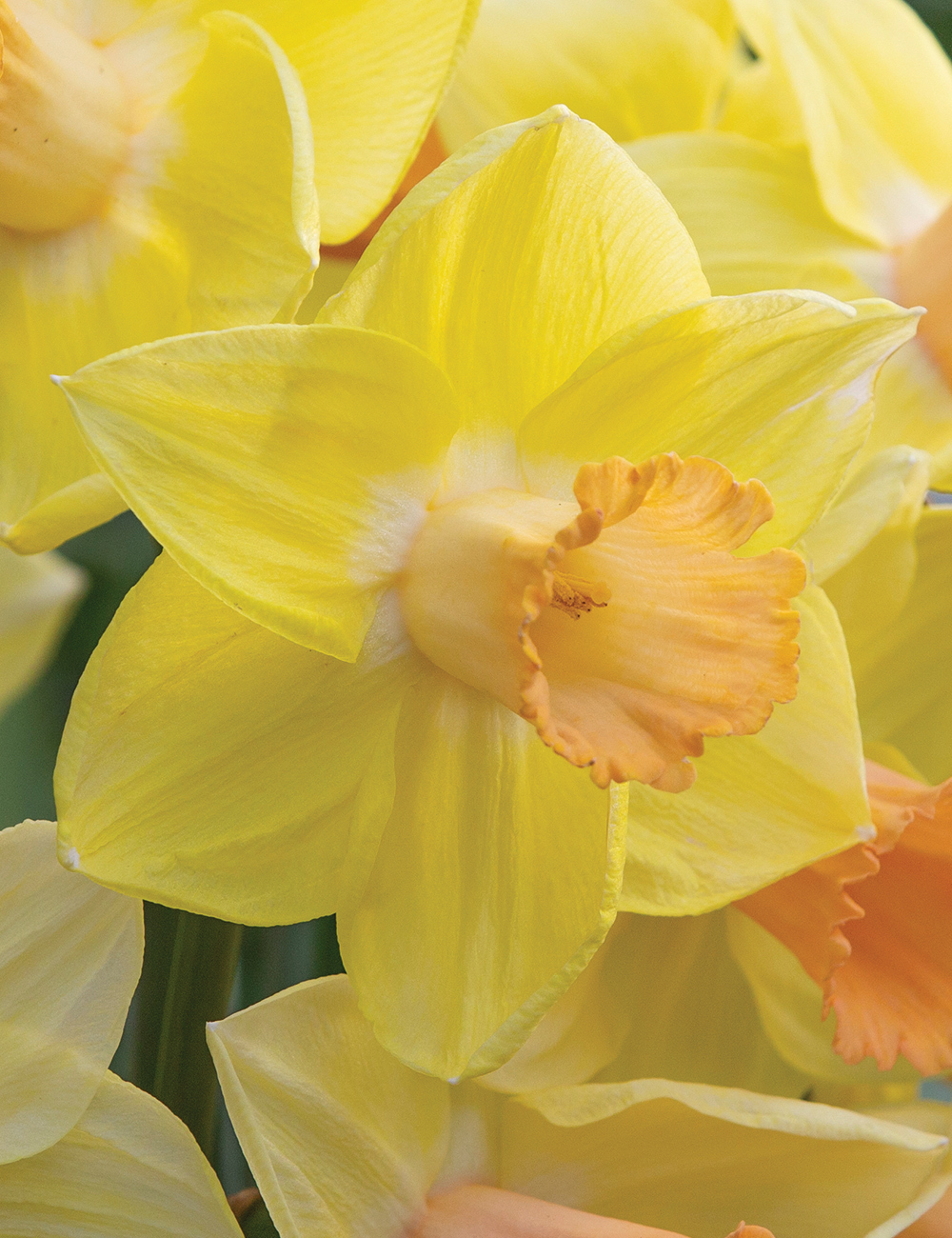 Narcissus ‘Billy Graham’ ~ Division 2 Daffodil, Large-cupped ~ Blooms, mid to late season
Narcissus ‘Billy Graham’ ~ Division 2 Daffodil, Large-cupped ~ Blooms, mid to late season
Good morning, dear friends. As you probably guessed this post is about daffodils. Therefore, as my opening photo, I had to show you my favorite daffodil ~ ‘Billy Graham.’ The beautiful combination of its soft yellow petals and the pink cup is unusual, and to me, very pretty. You will also notice it has a soft cream halo around the cup. It is a stunning addition to any garden. 
Daffodil, the flower which symbolizes friendship.
Today, I want to share some of what I have learned throughout my gardening life about daffodils. Much of this post is information I had the good fortune to learn during the time I was involved in garden club. Specifically, my experiences from entering horticulture exhibits in flower shows. As you will see, there is much to know about daffodils.
Now, perhaps you are wondering why I am sharing such detailed information. Certainly, you won’t need to know this information or need to know which daffodil belongs to which division ~ unless you’re a botanist, daffodil collector (yes, there are daffodil collectors), or planning to enter the horticulture division of flower shows. However, seeing the full range of possibilities is certain to inspire you. Perhaps you may see a division new to you and decide you simply must have a few. So, find your coffee or tea and let’s begin our ‘dance through the daffodils.’ I will be anxious to hear those which you have decided you ‘can’t live without.’

“Life is the greatest gift that could ever be conceived … A daffodil pushing up through the dark earth to the spring, knowing somehow deep in its roots that spring and light and sunshine will come, has more courage and more knowledge of the value of life than any human being I’ve met.” ~ Madeleine L’Engle
Daffodils are divided into thirteen divisions, and in each division, there are many cultivars. The following is the classification system of the Royal Horticulture Society and is also followed by the American Daffodil Society. I will explain the divisions and then show a favorite cultivar of mine from each division. Additionally, Miniatures have the same divisions as standards, only smaller blooms, usually less than 2 inches in diameter. Also note, under each photo, I have given the bloom time (Early, Mid and Late season). This information is important because, if you plan accordingly, you can have daffodils blooming from late March through the first of June. In the south, this would most likely be late February through the first of May.
Division 1 ~ Trumpet Daffodils ~ One flower to a stem; corona (“trumpet”) as long as, or longer than the perianth segments. (“petals”).
Example: The beautiful ‘British Gamble.’ Just look at her ruffled trumpet.
 Narcissus ‘British Gamble’ ~ Blooms Early to Mid Season
Narcissus ‘British Gamble’ ~ Blooms Early to Mid Season
Division 2 ~ Large-Cupped Daffodils
One flower to a stem; corona (“cup”) more than one-third, but less than equal to the length of the perianth segments (“petals”).
Example: Lovey Avalon
 Narcissus, ‘Avalon’ ~ Blooms, Mid Season
Narcissus, ‘Avalon’ ~ Blooms, Mid Season
Avalon is a beauty and always produces an abundance of blooms.
Division 3 ~ Small-Cupped Daffodils
One flower to a stem; corona (“cup”) not more than one-third the length of the perianth segments (“petals”).
Example: ‘Eliot Ming’
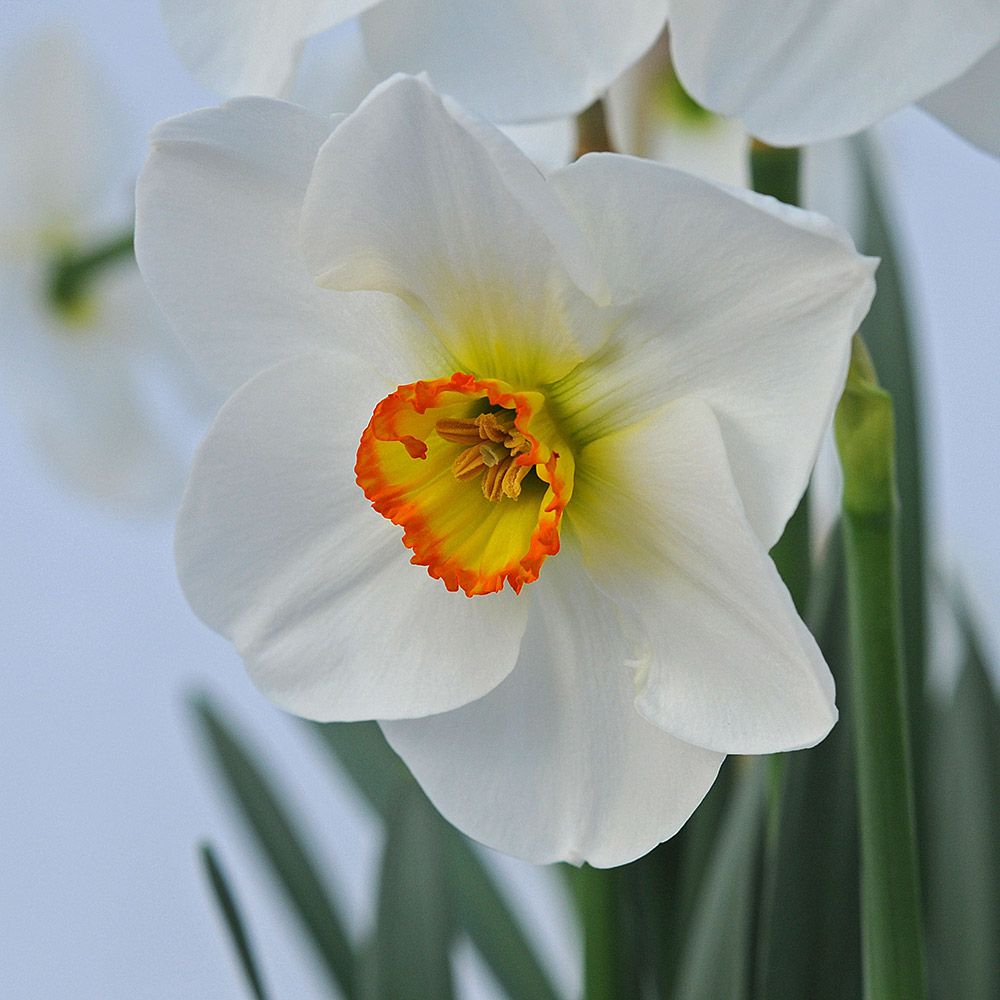
Division 4 ~ Double Daffodils
One or more flowers to a stem, with doubling of the perianth segments or the corona or both.
Example: Cheerful ‘Tahiti’ (a favorite of my husband).
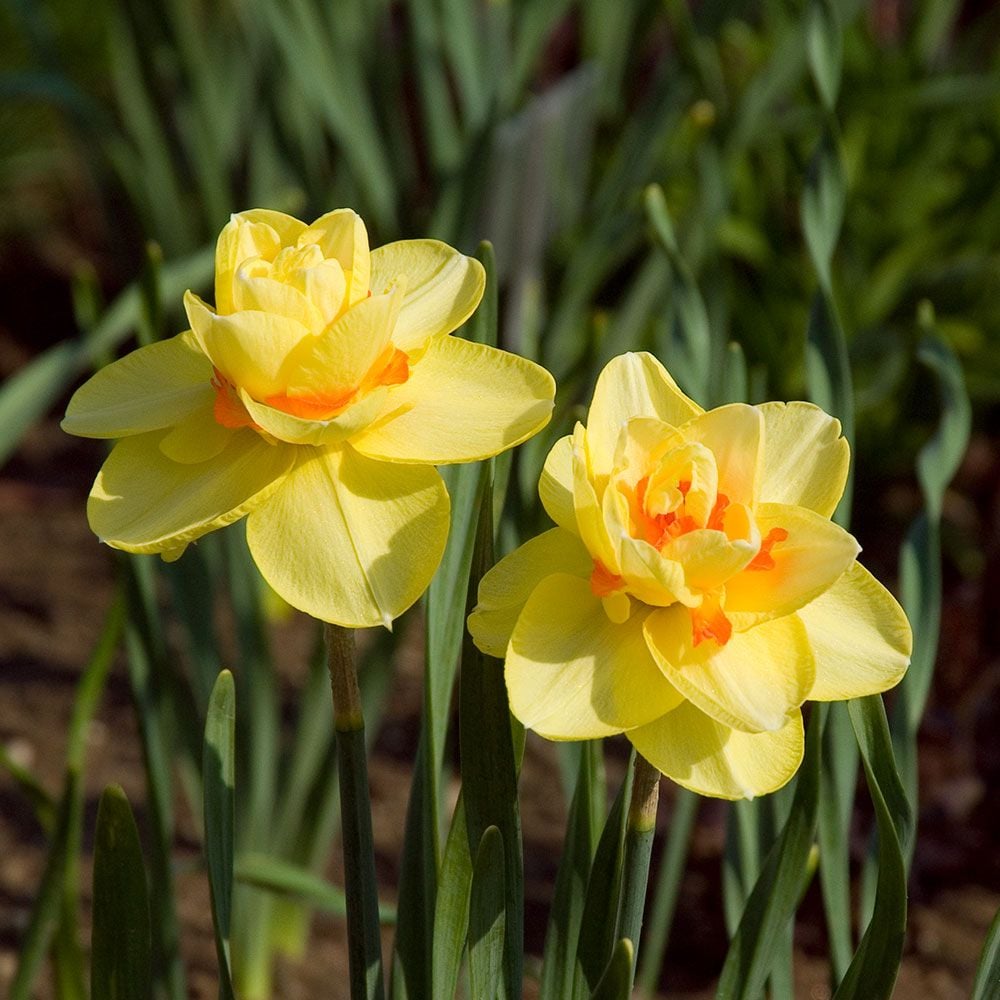
Look closely at the petals of Tahiti. This photo is wonderful as it shows the petals as they really appear ~ almost like crepe paper.
Division 5 ~ Triandrus Daffodils
Characteristics ~ Usually two or more pendent flowers to a stem; perianth segments reflexed.
Example: ‘Moonlight Sensation’
 Narcissus, ‘Moonlight Sensation’ ~ Blooms, Late Season
Narcissus, ‘Moonlight Sensation’ ~ Blooms, Late Season
Division 6 ~ Cyclamineus Daffodils
Characteristics ~ one flower to a stem; perianth segments significantly reflexed; flower at an acute angle to the stem, with a very short pedicel (“neck”).
Example: ‘Wisley’
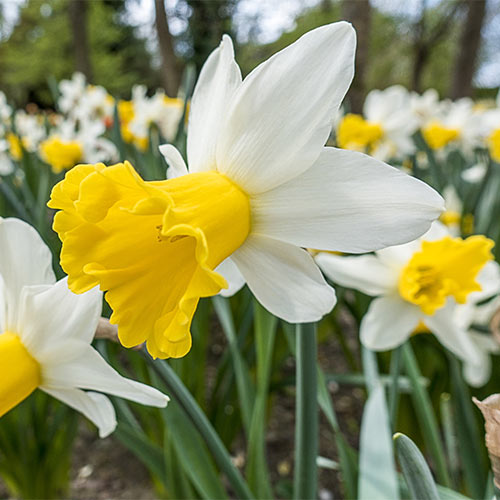 Narcissus, ‘Wisley’ ~ Blooms, Early to Mid Season
Narcissus, ‘Wisley’ ~ Blooms, Early to Mid Season
Cyclamineus Daffodil, Wisley
Narcissi ~The Art & Soul of Spring ~ unknown
Division 7 ~ Jonquilla Daffodils
Characteristics ~ Usually, one to five (rarely eight) flowers to a stem; perianth segments spreading or reflexed; corona cup-shaped, funnel-shaped or flared, usually wider than long; flowers usually fragrant.
Example: ‘Kedron’
 Narcissus, ‘Kedron’ ~ Blooms, Late Season
Narcissus, ‘Kedron’ ~ Blooms, Late Season
Division 8 ~ Tazetta Daffodils
Characteristics: Usually three to twenty flowers to a stout stem. Perianth segments spreading not reflexed; flowers are most often fragrant. Two stems are a bouquet.
Example: ‘Falconet’
 Narcissus, ‘Falconet’ ~ Blooms, Mid to Late Season
Narcissus, ‘Falconet’ ~ Blooms, Mid to Late Season
Division 9 – Poeticus Daffodils
Characteristics: Perianth segments pure white; corona very short or disc-shaped, not more than one-fifth the length of the perianth segments; corona usually with a green and/or yellow center and red rim, but sometimes wholly or partly of other colors; anthers usually set at two distinct levels; flowers fragrant.
Example: ‘Pheasant’s Eye’
 Narcissus, ‘Pheasant’s Eye’ ~ Blooms, Mid Season
Narcissus, ‘Pheasant’s Eye’ ~ Blooms, Mid Season
Pheasant’s Eye is an heirloom variety. Appearing in records as early as 1830. This is a lovely daffodil with petals like crepe paper and a pretty sheen.
Division 10 – Bulbocodium Hybrid Daffodils
Characteristics: Usually one flower to a stem; perianth segments insignificant compared with the dominant trumpet. This daffodil has a hoop-like shape and has grass-like foliage. It is a great selection for rock gardens.
Example: ‘White Petticoat’
 Narcissus, ‘White Petticoat’ ~ Blooms, Mid Season
Narcissus, ‘White Petticoat’ ~ Blooms, Mid Season
Division 11a – Split-Cupped Collar Daffodils
Split-corona daffodils with the corona segments opposite the perianth segments; the corona segments usually in two whorls of three.
Example: ‘Drama Queen’

Narcissus, ‘Drama Queen’ ~ Blooms, Late Season
Division 11b – Split-Cupped PapillonDaffodils
Split-corona daffodils with the corona segments alternate to the perianth segments; the corona segments usually in a single whorl of six.
Example: ‘Lemon Beauty’
 Narcissus, ‘Lemon Beauty’ ~ Blooms, Mid to Late Season
Narcissus, ‘Lemon Beauty’ ~ Blooms, Mid to Late Season
‘Lemon Beauty’ is a stand out in the garden.
Division 12 ~ Daffodils not fitting any of the above definitions.
I can’t imagine what would ever be in this division, unless it would be a new daffodil not yet named or assigned to a division.
Division 13 ~ Wild species of daffodils without names.
“Daffodils are yellow trumpets of spring.” ~ Richard L. Ratliff
 A clump of wild daffodils.
A clump of wild daffodils.
Most wild daffodils are a pale yellow, with a darker trumpet. The plant grows from a bulb and the flowers produce seeds. When germinated it may take five to seven years to produce a flower. Wild daffodils are not to be confused with heirloom daffodils, such as one may see in the countryside where old homes stand or once stood. We have an heirloom cultivar ~ Rip van Winkle. He came from my husband’s great grandparents home place in Western, Pennsylvania. He appears in records from 1881. I love his green swirls.
 Heirloom Narcissus(1881), ‘Rip van Winkle’ ~ Blooms Mid Season
Heirloom Narcissus(1881), ‘Rip van Winkle’ ~ Blooms Mid Season

In closing, I do hope this post has not been ‘information overload.’ However, I wanted you to see examples from all the divisions just in case there was a type of cultivar you were unfamiliar with and would like to possibly grow in your garden. At the end of the post, you will find reputable sources I have ordered from for years and I believe you will enjoy perusing through the selections they have to offer. And, you may want to check them out soon, as many of the special bulbs sell out quickly. Should you be in need of a little nudge to begin your planning, I believe you will find plenty of inspiration here.
And in closing, I opened this post with my favorite daffodil. I will close with my mom’s favorite. Mom knew her blooms and she always said, “White in the garden is the little black dress.”
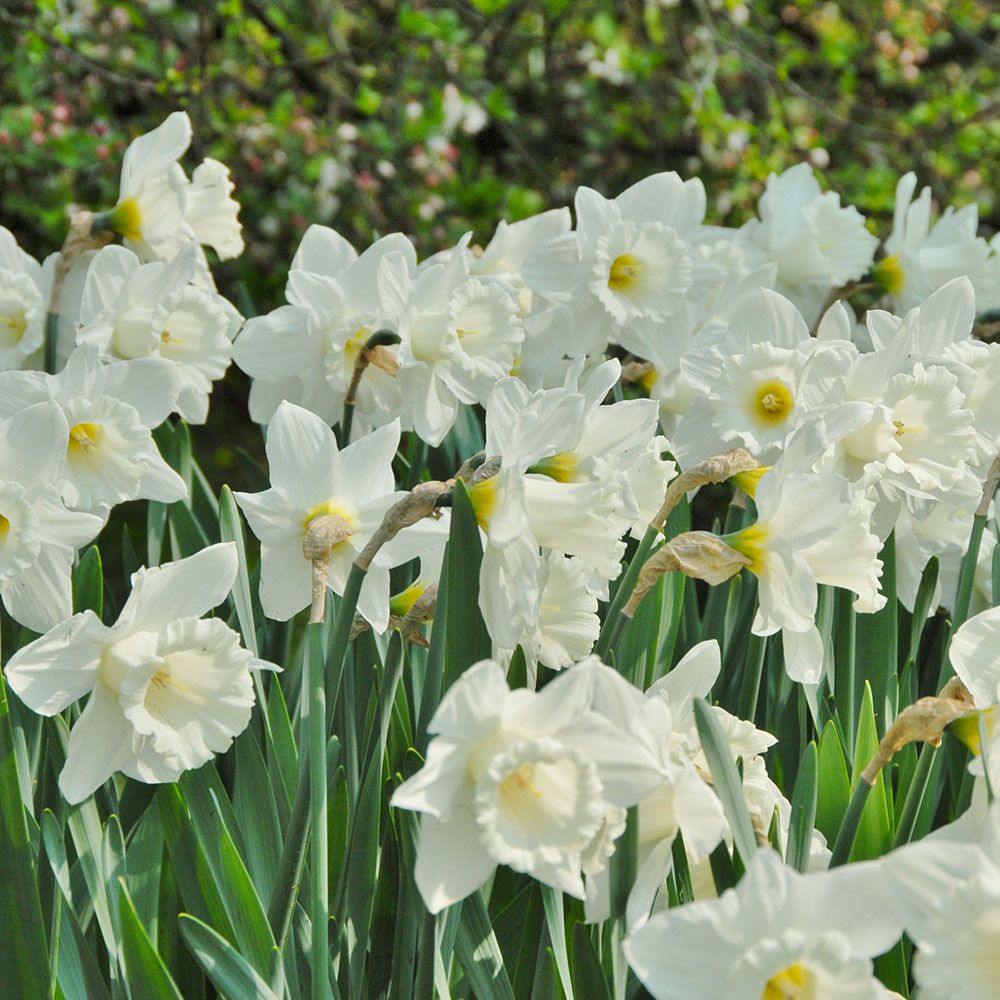
‘Mount Hood’ was awarded the Garden Merit Award by the Royal Horticulture Society and the coveted Wister Award by the American Daffodil Society. A vase of these daffodils is stunningly beautiful.

“Then my heart with pleasure fills and dances with the daffodils.” ~ William Wordsworth
Dear Friends, thank you so much for stopping by and I hope you have enjoyed your visit. Most of all, I hope you have seen something new and beautiful you want to add to your garden.
Know, I am wishing you glorious days ~ “Dancing With The Daffodils.”

Au Revoir,
Sandra
Notes: Narcissus is the botanical name for daffodil. The two are used interchangeably.
Sources for Daffodils:
- White Flower Farm ~ http://www.whiteflowerfarm.com/
- Brent and Becky’s Bulbs ~ http://brentandbeckysbulbs.com/
- John Scheepers ~ https://www.johnscheepers.com/
- Old House Gardens (a wonderful source for heirloom bulbs and plants) https://oldhousegardens.com/
Images: catalogs of White Flower Farm, John Scheepers, and Old House Gardens
That was wonderful, Sandra! I agree with your Mom about white in the garden being that “little black dress.” It makes all the colors around it shine! That said, my favorite daffodil is white “Thalia” which loves the dappled shade in my garden and looks stunning next to old-fashioned pink Bleeding Heart.
Thank you, Nancy. I know ‘Thalia’ and I know it must be lovely next to your pink Bleeding Heart. You sound like my mom, as she was always concerned about the colors of plants being happy beside each other. I try to be, and often don’t succeed. Happy gardening to you Nancy – it is just beginning to be garden weather here in WV.
Oh my, what a lovely post. And yes, all the information was a delightful read. I’m inspired to consider planting different varieties of these special bulbs in our garden. I’m smitten with the daffodils in England where they grow cottage gardens, in fields and ditches and along river banks, so it’s time to be more diligent about adding more in our own garden. I’m inspired by you!
To pick a favourite? Too hard! But your Wisely caught my attention because Rick and I visited that delightful garden during our visit to England in 2016. So it would be a lovely ‘keepsake’ to have Wisely in our own garden. We were there in July so the daffies were long spent, but no matter. The other variety that captured my eye and heart was the Pheasant’s Eye. Love that rim of fiery colour against the white petals. Like a ring of sparkling gems.
Thanks so much, Sandra!
Dear Brenda, so happy you enjoyed the post. And you will never go wrong with either of your selections. Wisley gets better each year. I adore his swept-back petals. He is blooming in front of our house at this time. Everyone who comes here always admires him. Happy Gardening, Brenda!
Brenda, if you have any trouble locating him, let me know. I have a source with a daffodil society.
Absolutely NOT info overload. I love daffodils, always have, always will. I love them even more since the deer tend to go for the tulips and leave the daffs alone! Such cheerful colors — they really say “spring” to me. But for all the love, I had little knowledge and this is interesting. Last year I missed planting more bulbs but hope to put some new varieties in the garden this year.
I just read your comment on your recent post but don’t know how to reply directly so I will hear. I have to say, your comments give me the biggest smile, every single time! Thank you.
Dear Jeanie, I am pleased you didn’t think this post was info overload. Daffodils are interesting with all their divisions. Yes, the deer will leave the daffies alone, and you are right they and the bunnies love tulips. Do check out the sources for bulbs I listed, you can order now and they will ship in the fall.
I so appreciate your visits and your kind comments. Enjoy spring, when it comes your way! ❤
Sandra, this is a post that I will use for reference time and again. I had no idea there was so much to know about daffodils. You have piqued my interest and I must order some of these varieties. I agree the Billy Graham is so beautiful and Pheasant’s Eye caught my eye. You are a treasure my friend. I love your passion for beauty, especially flowers and gardening!
Dear Pam, I do thank you for your kind words. You are a treasure to me and a continual source of inspiration. I am so pleased you enjoyed the post. Do place your order early as the special bulbs go quickly. Also, should you not be able to locate a particular bulb from any of the sources I listed, let me know I have a source with a daffodil society. They always order the beauties.
Happy Gardening, dear friend and enjoy these spring days. I remember that the heat of summer arrives early in the south. ❤